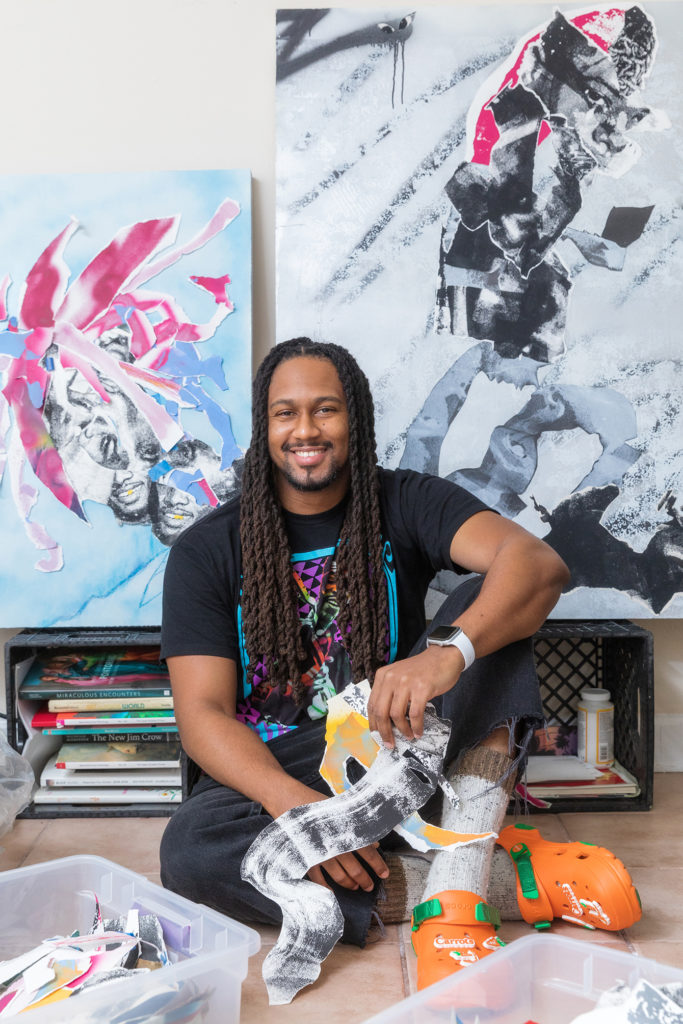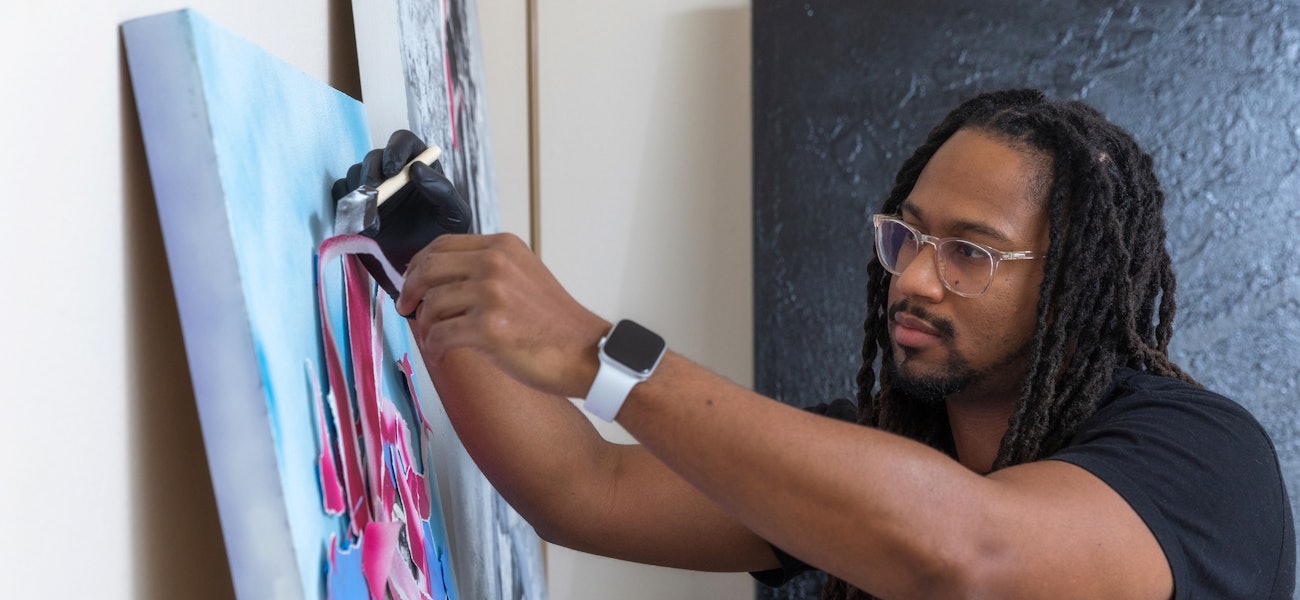Artist’s perspective:
“Right now, I’m working on some silkscreen-collage portraits that explore my identity as Barbadian and American. I’m exploring the similarities and differences, similar to what W.E.B. Du Bois describes as ‘Double Consciousness’ in his book, The Souls of Black Folk.

In Caribbean culture, ‘raggamuffin’ is a term used to refer to someone who is a roughneck or a streetwise tough guy. Other definitions of the term include a ragged, often disreputable person or a poorly clothed, dirty child.
Growing up in Barbados, a popular Soca/calypso/dancehall group named Square One made a party song called ‘Raggamuffin.’ After watching the music video and listening to the song, the word then became a term of endearment for myself and others throughout the Caribbean. I wanted to make a more contemporary depiction of the term. I’m interested in seeing my culture depicted in a fine-art setting.
For this work-in-progress piece, I was inspired by a portrait from a hairstyle-guide poster from my local barbershop in Baton Rouge. The image was scanned, transferred to Photoshop, then screenprinted, cut and pasted onto a spray-painted background. The hair was added after a personal longing for more representation of figures in style-guide posters bearing dreadlocks. This piece will be one of four works to be included in an upcoming exhibition at the Exchange Museum in Barbados called ‘Non Traditional: Contemporary Bajan Expressions.’”
More from the artist
What was your introduction to art?
My dad, who is now a priest, introduced me to art at an early age. I would see photos of Jesus, saints and other religious figures, so I became inspired by depictions of divine figures. That was my first memory of art.
For me, those early artistic exchanges between my father and I were the first realizations of what an art process could look like. He and I would sometimes draw on top of each other’s drawings or I would continue a drawing he initially drew; vice versa. These interactions helped to inform my current practice and personal interest in “the process” of creating.
For me, the process of creating, like screen-printing, cutting, tearing, and collaging, is equally as important as the finished work of art. To paraphrase one of my former college professors at SUNY Potsdam, paying attention to the process or the methods of creating in addition to our life experiences help to dictate the direction of the work.
What’s your take on the Baton Rouge art scene?
I see really interesting things happening in Baton Rouge, and I look forward to helping the art community thrive.
Can you describe one of your favorite pieces and walk me through the creative process behind it?
“I Am My Brother’s Keeper.” The idea behind it was I wanted to have siblings. I was an only child for 15 years and when I moved to the U.S. away from my family, I never got to hang out with my younger brother or sister. I wanted to connect with them through my painting. I made it using a collage, a Photoshopped photo of my brother, screenprint and an acrylic paint base for my thesis show in grad school. It ended up winning first place at [Ebb & Flow Festival’s] Art Flow event in 2019.
How has your experience as a Black man impacted your art?
As Black people, we are complex and multifaceted. Having been born and raised in Barbados and now being a United States citizen, I am both Bajan (Barbadian) and American. Being a Black man, there are many, many things I am constantly trying to unlearn. For example, it is important for us as Black men to be open to the notion of vulnerability.
This is why I look to Black barbershop culture as a point of departure. As a counterpoint to the stereotype that Black men and youth are dangerous, I sometimes photograph several subjects in a moment of casual vulnerability while sitting on the barbershop chair. I consider the role of conversation and community in the struggles Black people face today. While using visual and linguistic references that are commonly associated with Black culture, the work attempts to navigate the space between acknowledging the advantages of Black identity and recognizing the importance of individuality in representation.
I don’t see myself as a printmaker, but as an artist currently interested in approaching screen printing through the lens of an abstract expressionist. I have an interest in a radical and energetic approach to artmaking. I think, ‘How can I elevate the state of the human race from what we know?’
About the artist
Growing up, the Barbados native didn’t feel like Black people were being represented in the fine art world. Through his work, he wanted to depict Black people in an otherworldly, abstract and artistic way like he hadn’t seen before.
The 30-year-old visual artist makes art out of anything he can get his hands on. He has created mixed-media pieces from spray paint, acrylic paint, screen prints, silkscreen, wax, acrylic ink, enamel and oil paint sticks.
Alleyne’s work is a melting pot of his own life experiences and observations. At 16, he moved to Brooklyn, New York, where he was exposed to everything from fine art galleries to street art. His abstract collages featuring spray paint and paint splatters resemble the bold graffiti and posters that decorate the streets of New York ghettos.
In 2015, Alleyne moved to Baton Rouge to pursue his master’s of fine arts with a focus in studio art at LSU. In 2018, he graduated with concentrations in painting, drawing and printmaking. Since receiving his master’s, he has showcased his work from New York to Los Angeles and even Ireland. Locally, his art has been seen at the LSU Museum of Art, as well as Masur Museum of Art in Monroe and the Ogden Museum of Southern Art in New Orleans.
|
|
|
Alleyne is an assistant professor of art at Southern University. In 2020, he became an artist member of the Baton Rouge Gallery. johnalleyne.com
Portions of this article were originally published in the February 2021 issue of 225 magazine.





